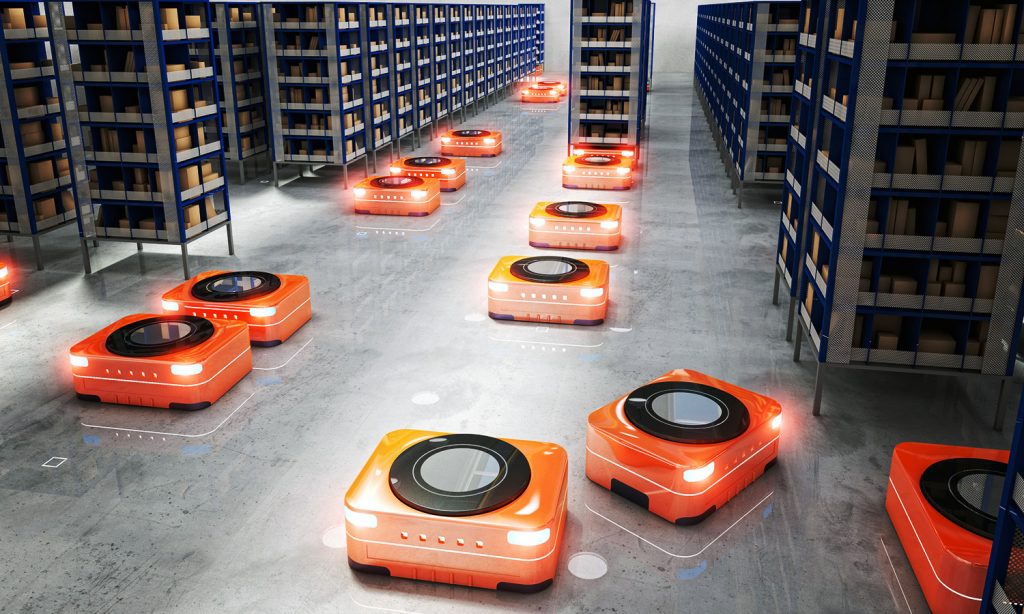Should your warehouse invest in robotics in 2021?
Adriana Glazer | 27. May 2021
Investing in automation or robotics to reduce costs and increase production is more in demand than ever in today’s market. Yet many companies face a variety of growing pains when trying to automate business processes. Especially if they are stuck in their habits. In this article, you will learn what challenges you should expect in the age of robotic automation and how processes in logistics centres can be optimised with the help of robotics.

3 advantages of robotics in your storage system:
Increased productivity in operational processes
By undertaking simple or repetitive tasks, employees in the company can be relieved and deployed for more complex activities. At the same time, errors are reduced and processes are executed precisely and efficiently. Since robots don’t need to sleep (except during recharging), they can continue to work on manual tasks to complete open orders on time long after your employees have gone home.
Improved picking, packing and shipping
Robots also eliminate human error when picking, packing and shipping orders. With all this data at their disposal, the robots ensure timely delivery of the order consignments by sheer efficiency.
Increased demand for high quality jobs
Robots reduce the repetitive, low-value work that your human employees normally deal with. This allows your staff to focus on high-value work that increases profits and satisfies your customers, such as B. customer care and quality control. As robots take over many manual tasks in the logistics centre, employees can avoid the unnecessary strain of constant walking and lifting. This not only better protects employees from overexertion, but also gives them the flexibility to work on more meaningful projects that improve your business and advance their careers.
Challenges of robotics in your storage system:
Avoid unplanned costs with the help of professional advice
Automation systems can be used to increase the quality and quantity of production processes. However, there are risks regarding spare part availability and durability of a robot, which can lead to unplanned costs. To prevent these problems, systems of established manufacturers should be used. This ensures a long-term and professional product support. In addition, an accurate planning of the application scenario should be carried out in advance. Here, questions are raised concerning the robustness, load capacity or the programming capability of the system used.
You will need employees to control robotic systems
Even if you introduce a fully autonomous fleet of robots, you still need employees to control, repair and supplement their activities. The reason is that robots cannot yet think on the same level as their human counterparts. They still need input and support from your human staff to work optimally.
A risk exists with regard to the possible lack of expertise in the maintenance of such systems. In order to avoid this, an appropriate maintenance strategy should be developed in co-operation with the manufacturer, which on the one hand ensures process reliability and, on the other hand, makes the costs predictable.
Many companies fear that they do not have enough resources to use complex industrial robot systems. As a rule, an infrastructure must be created to set up, programme and operate these systems. Here, the potential of Low Cost Automation becomes obvious. Significantly lower investment costs and a manufacturer-independent community often offer ample support. There is an enormous potential for use – particularly for companies that have hardly considered the topic of process automation so far.
New challenges for cyber security
As so-called “smart factories” increase their connectivity, they also bring greater cyber security challenges, such as:
Advanced malware threats that consistently spy on sensitive data.
Networked parts of the operating technology (OT) now become vulnerable to system attacks.
Accidental data loss – Not all cyber security breaches in the manufacturing industry are due to malicious attacks. Manufacturers should also consider training their staff on the importance of cyber security measures to prevent accidental data breaches and improve the overall security strength of the facility.
Several industries will see growth through the use of robotics in 2021
- Warehousing will continue to grow, but not in such large proportions as other industries because the use of robots is already so widespread throughout warehousing.
- Robots in the construction industry will help with construction, as well as provide more insight into critical problems, analysis, etc.
- Customised manufacturing: these niche players have been slower to adopt collaborative robots and are likely to have the highest growth overall.
- Agriculture: due to widespread labour shortages, there are sufficient economic incentives to ensure further development in this sector.
- Sanitary robots: Covid-19 triggered a boom for sanitary robot solutions in hospitals and industrial facilities. Industries that use automated sanitation solutions will continue to do so even as Covid 19-related demand begins to wane.
- Clean energy robots can help automate the production of solar panels for turbines and can also help remove dust from solar panels to ensure maximum performance.
(Source: www.freedomrobotics. ai)
Conclusion: manufacturers would notice significant changes in their production facilities during the transition to robotic automation. The benefits definitely outweigh the risks when you consider the true costs of implementing an autonomous robotic system. Robot technology is an exciting development for many industries around the world, offering increased productivity, accuracy and improved work-life balance.

